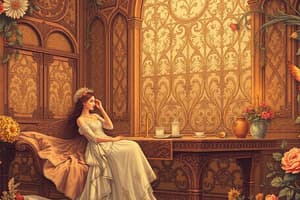Podcast
Questions and Answers
What element of art leads the viewer's eye throughout an artwork?
What element of art leads the viewer's eye throughout an artwork?
Line
What term refers to how things feel when touched?
What term refers to how things feel when touched?
Texture
What is the name of a specific color in the color spectrum?
What is the name of a specific color in the color spectrum?
Hue
What principle of art refers to the visual weight of the elements of the composition?
What principle of art refers to the visual weight of the elements of the composition?
What principle of art is the difference between elements of art in a composition?
What principle of art is the difference between elements of art in a composition?
Flashcards
What is a Line in art?
What is a Line in art?
A mark with length and direction, used to lead the viewer's eye throughout artwork.
What are Shapes in art?
What are Shapes in art?
A two-dimensional area showing an object's form, either geometric or free-form.
What is Space in art?
What is Space in art?
Outer and inner areas; the emptiness/area between, around, above, below, or within objects.
What is Texture in art?
What is Texture in art?
Signup and view all the flashcards
What is Balance in art?
What is Balance in art?
Signup and view all the flashcards
Study Notes
- Module 001 covers the Elements and Principles of Art
Lines
- A line leads the viewer's eyes throughout artwork.
- A line leads eyes into, around, and out of visual images within the artistic frame.
- While lines have both width and length, the length occupies more space.
Shapes and Form
- Shapes are two-dimensional areas which demonstrate the form of an object and its layout in space.
- Dimension refers to the measure of shape an object occupies in one direction.
- Shapes may be geometric or free-form.
Spaces
- Space includes outer and inner space; the emptiness and area between, around, above, below, or within objects.
- Space may be flat or two-dimensional, like in painting, or three-dimensional, like in monumental sculpture.
Texture
- Texture is how things feel when touched.
- Tactile texture is experienced when touching something.
- Visual texture occurs when looking at a photograph or image with texture, reminding you how those objects feel.
Colors
- Color results from the light waves reflected from objects.
- Hue is a specific color's name in the color spectrum or the bands of color in a color wheel.
- Value is indicated through the lightness or darkness of a color.
- The amount of light in a color determines the color value.
- Tint is the light value of a hue.
- Shade is the dark value of a hue.
- Intensity is the brightness or dullness of a hue.
Balance
- Balance is the visual weight of the elements of the composition.
- It gives the painting a stable and "right" feeling.
- Imbalance causes discomfort in the viewer.
Emphasis
- Emphasis is when the artist creates a visually dominant area, commanding the viewer's attention.
- Emphasis is often achieved by contrast.
Contrast
- Contrast is the difference between elements of art in a composition.
- Each element is made stronger in relation to the other through contrast.
- Contrasting elements command the viewer's attention when placed next to each other.
Movement
- Movement occurs when the use of elements of art moves the viewer's eye around and within the image.
Rhythm
- Rhythm is created by movement implied through the organized repetition of elements of art in a non-uniform way.
- Rhythm relates to rhythm in music and relies on variety, unlike pattern which demands consistency.
Pattern
- Pattern is the uniform repetition of any of the elements of art or any combination thereof.
- Classic patterns include spirals, grids, and weaves.
Unity and Variety
- A painting should feel unified and have elements that fit together comfortably.
- Too much unity creates monotony, while too much variety creates chaos.
Studying That Suits You
Use AI to generate personalized quizzes and flashcards to suit your learning preferences.




